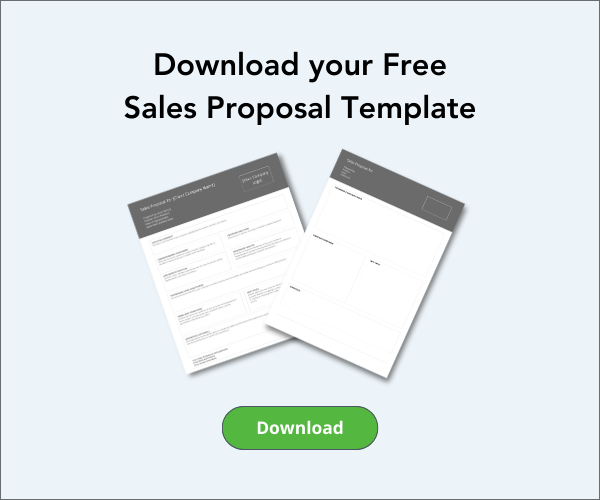
When a deal gets to the stage of requiring a sales proposal, it’s always an exciting time. After all, not every lead progresses through the pipeline to the point where it’s appropriate to send a full-on proposal. Only the prospects who show a serious amount of interest end up necessitating them, so it’s often a harbinger of a deal that’s begging to be closed.
However, it’s a mistake to count your chickens before they hatch, and a poor sales proposal is the perfect way to lose an otherwise promising deal from right under your nose.
Crafting a compelling sales proposal is a critical step in every deal. The best proposals act as bridges between the initial pitch and the actual closing stages. It shouldn’t only highlight the value of your product or service, but should ideally address the specific needs and concerns of the potential client you’ve come to understand throughout the process.
And, of course, a good sales proposal should nudge the prospect towards a positive decision, without making any major missteps that could result in scaring them off.
In the following blog post, we’ll be going through the key components of an effective sales proposal and exploring the steps involved in building out your own. We’ll also include a sample sales proposal template you can use to act as a jumping-off point for when it comes time to craft your own.
Sales Proposal Basics
At its most fundamental level, a sales proposal is a document designed to offer solutions to a potential customer’s specific problems via the products or services you’re selling. A common mistake made by newcomers to the world of sales is thinking the price quote is the be-all, end-all of the proposal.
That mindset doesn’t just lead to a unidimensional way of thinking about the deal. It also risks hyper-focusing on the most significant point of friction for the client, potentially alienating them right at the moment of truth.
You should aim to outline in some detail how your offering is the best fit for the client’s unique needs, supporting your claims with as much data and hard evidence as possible. Think of a sales proposal as a way of crafting a compelling narrative. You want to tell a story that starts with the client’s problems, takes them through a journey of potential benefits from solving those problems, and ultimately positions your product or service as the perfect solution.
Telling a convincing story will go some distance to taking the pain out of the price, which is by far the most common sales objection.
By the way, if you want to learn more about sales objections and how to handle them, check out the blog post we wrote on that exact subject here.
How to Create a Sales Proposal
Step 1: Research and Preparation
Going into the process of writing a sales proposal blind is a surefire recipe for disaster. It’s absolutely vital that you understand your client’s business, challenges, and industry. Ideally, this is all information you’ll have gathered throughout the earlier stages of the sales process, so none of it should come as a particular surprise.
If you find yourself struggling to answer these major questions, it might be worth considering whether it’s the right time for a proposal or whether you should focus on gathering more information.
Doing your homework in the research and preparation stage will pay dividends by allowing you to tailor your proposal to the client’s specific situation. This doesn’t just make them feel heard. It positions you as a figure of genuine authority, and somebody who’s credible enough to trust with solving their problems.
Step 2: Define the Problem or Need
The proposal should begin by clearly defining the problem or need that your client is dealing with. Don’t fall into the trap of starting out with the solution, or by pitching your company’s products or services right away.
While it may be tempting to get straight to the “good stuff”, in reality all this achieves is making the client wonder if you understand their situation at all. Demonstrating your understanding of the situation builds trust and sets the stage for presenting your solution. There’s no reason to be afraid of getting detailed at this stage.
The more information you can pack in about how thoroughly you understand the problems they’re facing, the more appealing your solution will feel when you present it in the next step.
Step 3: Propose a Solution
This is the core of your proposal. It’s where you get to really show how compelling your company’s offer is, and why it’s the perfect solution to the problems your client is dealing with. Be as specific as you can about the features of your proposed answer to their questions, explaining why your solution is the best choice.
While you do need to discuss the features of your offering, it would be a mistake not to discuss how much the client’s life is going to improve after deciding to work with you. Often, actual benefits are more compelling than nuts-and-bolts features.
By being explicit about exactly how they’re going to benefit from your solution, you’re giving yourself a great chance at crafting that compelling narrative we mentioned earlier and building on your strong start.
Step 4: Detail the Implementation Plan
There’s not much point in providing a solution without giving clear guidelines as to how it’s going to be implemented. That’s going to leave a lot of room for guesswork in your client’s mind, which is the absolute last thing you want in a well-developed deal that’s approaching the closing stage.
Your implementation plan should include timelines, phases, any required client inputs, and a few notes on how potential disruptions will be minimized during the transition period as they implement your solution. Try to present it in a straightforward, step-by-step outline that’s clear without skimping on detail.
Step 5: State the Investment and ROI
There are no two ways about it: investment costs are a major pain point. No matter how excited the client is about the solution or how much trust you’ve managed to develop in the relationship up to this point, nobody likes thinking about the amount of money they’re going to have to spend.
The key to navigating this tricky step of the proposal is to be as transparent as possible. Tell it exactly like it is, without sugarcoating or pulling punches, and your customer will appreciate it. A good way to soften the blow without losing transparency is by illustrating the potential ROI.
This won’t feel sleazy. Rather, it’ll come across like you’re focused on the benefits to their business and their unique situation.
Step 6: Add Testimonials and Case Studies
Social proof never hurts, and there’s no better place to include it than right after the major pain point of pricing. By incorporating testimonials from previous clients and relevant case studies that demonstrate the success of your solution in similar situations, you’ll be subtly enhancing your offer’s credibility and continuing to build on the positive problem-solving spirit of the proposal thus far.
Third-party validation can be a significant tool to build trust and reduce friction. Don’t be afraid to leverage it as much as you can.
Step 7: Address Potential Objections
We’re going to let you in on a secret: clients will raise objections to even the most perfect solutions. It’s part and parcel of the sales world. A good way to get out ahead of these concerns is to anticipate them and address them yourself.
This shows that you’ve thought through the proposal from all angles and are prepared to support the customer through any potential uncertainties that may arise.
Step 8: Include a Clear Call-to-Action
Finally, don’t let your proposal simply linger there in your client’s inbox, waiting to be read. You should always aim to finish with a clear call-to-action (CTA) that guides the client on the next steps. This will reduce the chances that the deal dies off through inaction and ensure you’re able to power through to the finish line of actually closing the deal.
Strong CTAs are clear, simple, and easy to follow. Whether it’s scheduling a meeting, signing a contract, making a payment, or anything else, you should provide all the details necessary for your client to take the step you’re asking them to without needing to check in for further information or allowing room for misunderstanding.
End your proposal with a clear call-to-action (CTA), guiding the client on the next steps. Whether it’s to schedule a meeting, sign a contract, or make a payment, the CTA should be clear and easy to act on.
Conclusion and Free Template
A well-crafted sales proposal will make all the difference when it comes to your chances of winning new business. By showing that you thoroughly understand your client’s needs, have a tailored solution to offer, and are capable of effectively communicating the value and benefits, you’ll be able to stand out from the crowd and give yourself a great chance of closing the deal.
Remember to always keep the client and their situation at the center of your proposal, to personalize your approach as much as possible, and to maintain a professional tone throughout. Prepare carefully, pay attention to the details, and the big-picture issues will take care of themselves.
To get you started, we’ve taken the liberty of drafting a sample sales proposal template you can use to build on as you set about crafting your own proposals to use in your deals. Don’t worry about getting too bogged down in following it to the letter, however. It’s best used as a rough guideline to tweak and refine according to your specific needs.

FAQ
A sales proposal is a document that outlines the solution your product / service offers to a potential customer’s specific problems. It’s important because it bridges the gap between initial interest and the closing stages, helping to convince the prospect to make a purchase decision.
Key components include defining the client’s problem, proposing a tailored solution, detailing the implementation plan, stating the investment and expected ROI, including testimonials and case studies, addressing potential objections, and providing a clear call-to-action.
To ensure your proposal addresses the client’s needs effectively, conduct thorough research on the client’s business and challenges, tailor your solution to their specific situation, and provide detailed, data-backed explanations of how your product or service will benefit them.


